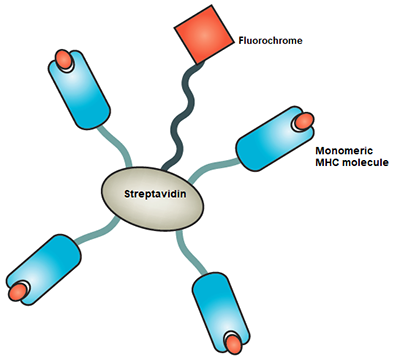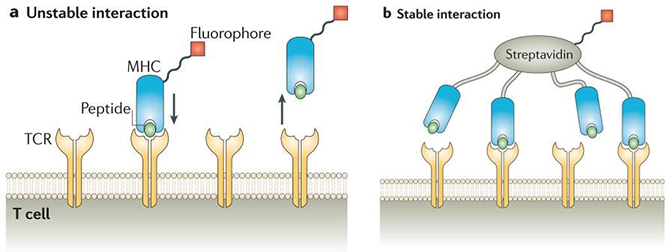MHC tetramer is a complex of 4 MHC molecules associated with loaded peptide, which is bound to a fluorescently labeled streptavidin molecule. Monomeric MHC molecule is loaded with its cognate peptide, and biotin is linked to the complex at a site far removed from the T-cell recognition site. The monomeric MHC-peptide complexes bind to streptavidin, which further tightly binds biotin at 4 separate sites, thus making a tetrameric complex, the MHC tetramer. Creative Peptides provides custom MHC-peptides tetramer service to meet the unique requirements of customers' research or treatment goals.

MHC tetramers are used in immunology research to track T cells in various samples. They are composed of four MHC molecules linked to a selected peptide, creating a stable set. The responsibility of MHC molecule is to transfer this peptide to T cell receptors, which is how the tetramer works. This enables accurate measures and follow-ups of certain T cell groups.

To comprehend the workings of an MHC tetramer in detail, knowledge of MHC class I and II peptides is fundamental. Generally speaking, MHC class I peptides primarily handle intracellular threats such as viruses and some types of bacteria. These peptides usually consist of 8-10 amino acids and interact with CD8+ cytotoxic T cells. Conversely, MHC class II peptides, responsible for countering extracellular organisms like bacteria, fungi, and parasites, are substantially lengthier, often containing 13-25 amino acids.
Further, MHC class I molecules generally present endogenous peptides/proteins, including those derived from the host's normal proteins (self-antigens) and those created by intracellular pathogens (non-self antigens). Self-antigens are crucial in maintaining self-tolerance, while non-self antigens trigger an immune response towards the invading pathogens. Compared to MHC class I, the longer length of MHC class II peptides facilitates the formation of multiple contacts with the MHC molecule, enhancing the stability of the peptide-MHC complex. This length is instrumental in ensuring that the complex persistently communicates with T helper cells until the immune response is achieved satisfactorily. The pathogen may be processed and presented to cytotoxic T cells more quickly due to the shorter length of MHC class I peptides, which guarantees a prompt immune response.
In simpler terms, an MHC tetramer is a science tool that helps spot specific T cells in different samples. Consider the MHC tetramer as a produced cluster consisting of four major histocompatibility complex (MHC) molecules connected to a particular tracking peptide. This cluster's purpose relies on the MHC molecule's capacity to expose this antigenic peptide to T cell receptors, which makes the tracking and counting of specific T cell groups possible. After this complex has been successfully added to a cell sample, the MHC-peptide tetramer-recognized T lymphocytes can be separated by fluorescence-activated cell sorting (FACS). Finding these T cells could help understand the workings of the immune system, which could advance studies of pathogenic immunity and aid in the creation of new treatment approaches.
Monitoring the immune response to specific pathogens by counting and characterizing the T cells that are activated by an infection provides critical data for developing efficient vaccines and studying disease pathogenesis. Furthermore, the insights gained could have vital implications for understanding the mechanisms of autoimmune disorders, where the immune system mistakenly targets the body's own cells, tissues, and organs.
Overall, with its capacity to detect, track, and provide a comprehensive analysis of antigen-specific T cells, the MHC-peptides tetramer serves as an invaluable tool in immunological research. Its broad application in the study of antigen-specific immune responses gives it a prominent role in enhancing our understanding of complex immune system processes and developing novel therapeutic strategies to combat a range of diseases.
High Affinity and Specificity: MHC tetramer is composed of four MHC-peptide monomers, which can directly recognize TCR on the surface of antigen peptide-specific CD8+ T cells and has high affinity with TCR of antigen peptide-specific CD8+ T cells. This direct identification method makes MHC tetramer more specific and can locate and detect target T cells more accurately.
High Sensitivity: MHC tetramer technology can label target T cells at single cell level, and analyze the cells by flow cytometry, so as to realize qualitative and quantitative detection of antigen-specific T cells. This high sensitivity makes MHC tetramer have a wide application prospect in immunology research.
A Wide Range of Applications: MHC tetramer technology has been widely used in vaccine research and development, cell therapy research and other fields. In addition, MHC tetramers also play an important role in the field of cancer newborn antigen therapy. Because there are many gene mutations and individual differences in tumor cells, each patient may have many specific newborn antigens. MHC tetramer technology can verify these specific antigens one by one, providing new possibilities for cancer treatment.
Non-Invasive: MHC-peptide tetramer staining is a non-invasive technique, it relies on flow cytometry or fluorescence microscopy to identify T cells binding to the tetramer.
Quantification: This technique allows quantification of T cells, providing an accurate measure of the frequency of antigen-specific T cells in a population.
Multiplexing: Different tetramers can be conjugated with different fluorochromes, allowing simultaneous detection of T cells specific for multiple antigens.
Longitudinal Studies: MHC-peptide tetramers can be used in longitudinal studies to monitor changes in the frequency of antigen-specific T cells over time.
Fast and Efficient: The process is faster and more efficient compared to other methods like limiting dilution assay or ELISpot.
MHC-peptide tetramer staining is a popular technique for identifying particular T lymphocytes visually. The fluorescently labeled tetramer attaches itself to T cells that are able to identify the peptide specific to the tetramer. The detected T cells in this complex glow when seen under a fluorescent microscope, making it possible to identify, measure, and examine the cells in more detail. This test greatly advances our knowledge of immune responses by enabling the precise and direct identification of T cells that are specific to antigens.
In conclusion, the development and utilization of MHC tetramers have revolutionized our understanding of immune responses at the cellular level. Through these complexes, the specifics of the body's defenses can be mapped in detail, shedding light on human immunity's intricacy and elegance.
The MHC peptide tetramer has a critical role in immunology for tracking particular T cells. It identifies T cells with receptors matching a peptide antigen. The result of this matching is that MHC-peptide tetramers give a visual of how T cells are responding to a specific pathogen or vaccine. Mature T cells belonging to the CD8 or CD4 classes have αβ T cell receptors (TCR) that are particular to a molecular complex made up of an MHC class I or II molecule attached to a distinct foreign peptide or self-peptide. This visualization tool is vital in researching immune responses.
Creative Peptides is offering MHC tetramer synthesis with a set of peptide sequences customized by customers now. Here is a list of available alleles that Creative Peptides can provide. Currently two choices of fluorochrome labeling are available based on customer's request: phycoerythrin (PE) or allophycocyanin (APC). Creative Peptides also provides clinical grade tetramer for our clients. These highly purified products can be used in immunotherapy trials. Creative Peptides can supply different MHC-peptide tetramers that are specific to distinct antigens in cancer, autoimmune illnesses, infectious diseases, transplantation, and other antigens.
Every step of peptide synthesis is subject to Creative Peptides' stringent quality control. Typical delivery specifications include:
Below is the related products:
In the production of tetramers, the MHC heavy chain protein, the light chain protein and the epitopic peptide are refolded into MHC complex in vitro. The successfully refolded monomers are purified by gel-filtration and then biotinylated and stored at -80 °C. The biotinylated monomers are bound to fluorescent- labeled streptavidin, generally APC or PE before use. Streptavidin has 4 available binding sites for biotin, thus making a tetramer of MHC molecules with bound peptides. Details of the protocols can be found at NIH Tetramer Core Facility's website.
Note: Custom tetramers may differ significantly in refolding, stability and staining of T cells. It is much dependent on the MHC alleles and the binding affinity of a specific peptide to the MHC molecule. Creative Peptides recommends testing of every new batch of MHC tetramers with positive and negative control cells by titration of the tetramer reagent. Tetramers should be stored at 4 °C and retested after long-term storage.
References